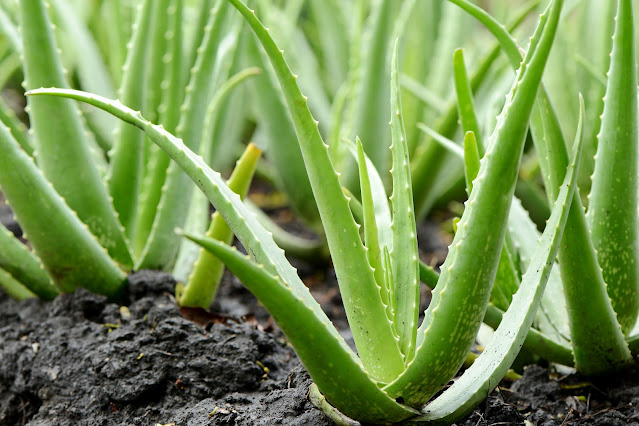Medicinal plants offer
natural remedies for skin burns, harnessing anti-inflammatory and antioxidant
properties to aid healing and minimize scarring.
Medicinal plants have long
been recognized for their therapeutic properties in treating skin burns. Aloe
vera, renowned for its cooling and soothing effects, is widely used to
alleviate pain and promote healing in burn wounds. Its gel contains
polysaccharides, vitamins, and minerals that facilitate tissue repair and
reduce inflammation. Calendula, another potent medicinal plant, possesses
anti-inflammatory and antimicrobial properties, making it effective in
preventing infection and promoting wound healing. Lavender oil, derived from the
lavender plant, is known for its analgesic and antiseptic properties, providing
relief from pain and preventing bacterial growth in burn wounds. Additionally,
chamomile, with its anti-inflammatory and antioxidant properties, accelerates
wound healing and reduces scarring. These medicinal plants offer natural and
safe alternatives for managing skin burns, offering relief from pain and
promoting optimal healing without adverse effects.
In many places, especially
in poorer countries, treating burns is hard with expensive treatments. Some
studies found that using certain plants can be better for healing burns and
reducing swelling compared to regular treatments. These plants include Albizia
julibrissin, Alkanna tinctoria, Aloe vera, Arnebia euchroma, Betula pendula and
Betula pubescens, Centella asiatica, Hippophaë rhamnoides, Juglans regia,
Lawsonia inermis, and mixtures of Matricaria chamomilla and Rosa canina. These
plant extracts might help treat burn wounds and sunburn because they have
different ways of working and can kill bacteria. They're also cheaper and safer
to use than regular treatments.
The skin is a big part of
our body and does many important things like protecting our organs, absorbing
things through it, keeping our body shape, saving fluids, controlling
temperature, and feeling things. Skin diseases are a big health issue around
the world. Burns are one common problem that hurts the skin, and they can
happen to anyone. Burns happen when something hot, electrical, or chemical
damages the skin. To treat burns, doctors usually put a soothing and protective
medicine on the skin to stop infections. People have been using plants to heal
wounds and burns for a long time. They make ointments from different plants
because they have many helpful things like terpenoids, tannins, and oils. These
things can help with cancer, diabetes, and fighting germs. Scientists have
found that some parts of plants help burns heal faster. Using plants for
medicine is not only cheap but also safe. Scientists are looking more into
plants to find new ways to help heal wounds. Many countries are focusing on
using natural resources, like plants, for medicine. These plants help treat
infections and add taste and color to food.
Albizia julibrissin:
Albizia julibrissin, known
for its triterpene saponins, has been traditionally used in folk medicine for
various ailments including wounds. A study showed its 5% gel extract
significantly reduced pain and inflammation in second and third-degree burns
compared to SSD cream, expediting epithelialization.
Aloe vera:
Recognized for its
therapeutic properties, Aloe vera cream demonstrated effectiveness in treating
second-degree burns, notably reducing healing time and wound size compared to
SSD cream, emphasizing its potential in burn management.
Arnebia euchroma:
A prospective study
highlighted the efficacy of Arnebia euchroma ointment in second-degree burns,
displaying faster wound closure and smaller wound size compared to SSD cream,
with higher patient satisfaction and lower pain sensation.
Betula pendula:
Birch bark extract, particularly Oleogel-S10,
exhibited superiority over octenidine hydrochloride gel in superficial
partial-thickness burn wounds, accelerating wound closure and garnering higher
satisfaction rates from both patients and investigators.
Camellia sinensis:
Green tea extract cream
demonstrated comparable effectiveness to SSD cream in treating second-degree
burns, showing potential benefits in wound healing, although further studies
are warranted to elucidate its full therapeutic potential.
Centella asiatica:
Centella asiatica, a plant
from the Apiaceae family, boasts therapeutic potential for skin burns owing to
its rich composition of terpenoids, including asiaticoside and asiatic acid.
Clinical trials have highlighted its efficacy in improving cognitive functions,
reducing anxiety, and enhancing wound healing. In a randomized clinical trial
comparing Centiderm® ointment with 1% SSD cream for treating second-degree
burns, Centiderm® demonstrated superior outcomes in terms of wound healing
time, pliability, vascularity, and subjective comfort, showcasing its
effectiveness in burn care.
Hippophaë rhamnoides:
Hippophaë rhamnoides, also
known as sea buckthorn, is renowned for its anti-diabetic, anti-obesity, and
cardiovascular benefits. In a triple-blind clinical trial, sea buckthorn cream
exhibited remarkable efficacy in promoting the healing of second-degree thermal
burns compared to 1% SSD cream. The shorter average wound healing time observed
with sea buckthorn cream underscores its potential as a valuable adjunct in
burn management.
Juglans regia:
Juglans regia, commonly
known as walnuts, offers a natural remedy for skin ailments due to its
antioxidant, anti-inflammatory, and antibacterial properties. A retrospective
evaluation comparing walnut ointment with conventional treatments and surgery
for non-healing burn wounds revealed promising results. Walnut ointment
demonstrated comparable effectiveness to surgical intervention, with
significantly shorter wound closure times and higher success rates compared to
conventional treatments. This highlights the therapeutic potential of walnuts
in facilitating burn wound healing.
Alkanna tinctoria, :
A clinical study explored
the efficacy of a mixture comprising Alkanna tinctoria, beeswax, and olive oil
in treating burn wounds. The concoction, prepared by adding beeswax to medical
olive oil and Alkanna tinctoria, exhibited promising results. Patients treated
with this mixture experienced faster re-epithelialization (3.0 ± 0.85 days)
compared to the control group (6.79 ± 1.77 days). Moreover, the application of
the natural mixture led to significantly reduced pain levels and shortened
hospitalization durations, highlighting its potential as a therapeutic option
for burn injuries.
Centella asiatica:
In a randomized clinical
trial, dressings containing Aloe vera and Centella asiatica were compared to
standard dressings for treating second-degree burns. The group treated with
herbal extracts showed accelerated wound healing (18.53 ± 1.66 days) and
shorter hospital stays (21.12 ± 1.83 days) compared to the standard group.
Despite one case of infection, no adverse effects were observed, indicating the
safety and efficacy of Aloe vera and Centella asiatica in managing burn
injuries.
Lavandula stoechas :
A double-blind clinical
trial evaluated the effectiveness of a herbal mixture containing Aloe vera gel,
Lavandula stoechas, and Pelargonium roseum essential oils in treating burns.
While both groups experienced reduced pain and improved wound healing, the
experimental group exhibited lower pain intensity and fewer infections. This
suggests the potential of herbal formulations as alternative therapies for burn
management, with Aloe vera playing a pivotal role in enhancing healing
outcomes.
Azadirachta indica Oil
A retrospective study
investigated the efficacy of a spray containing Azadirachta indica and
Hypericum perforatum oils in treating burn wounds. The preparation induced
granulation tissue formation and epithelization, leading to accelerated wound
healing (16.6 ± 4.69 days) and pain relief. No adverse effects were reported,
highlighting the safety and therapeutic potential of plant-based preparations
in managing burn injuries.
Lawsonia inermis
Fundermol ointment,
comprising Lawsonia inermis and beeswax, demonstrated efficacy in treating
severe burns compared to 1% SSD cream. Patients treated with Fundermol
experienced significantly shorter wound healing times (4.4 ± 1.87 days),
indicating its potential as a promising therapeutic option for burn management.
This underscores the importance of exploring natural remedies for enhancing
wound healing and improving patient outcomes.
Curcumin:
Curcumin, a polyphenol
compound found in turmeric, exhibits potent anti-inflammatory and wound healing
effects. Incorporating curcumin in wound dressings enhances antioxidant
activity and expedites wound reduction. Its ability to suppress inflammatory
cytokines like TNF-a and IL-1 makes it a promising candidate for managing
hyperinflammatory burn wounds. Moreover, curcumin inhibits fibroblast
proliferation and excess collagen synthesis, making it effective in preventing
hypertrophic scarring and keloids.
Terminalia genus:
Certain species of
Terminalia, such as Terminalia chebula, demonstrate wound healing properties
attributed to their antioxidant and anti-inflammatory effects. Extracts of
Terminalia chebula accelerate wound healing and inhibit NF-B activation, making
them beneficial for hyperinflammatory wounds like diabetic ulcers and burns.
Additionally, Terminalia sericea exhibits antimicrobial activity against
various pathogens commonly associated with wound infections.
Zanthoxylum bungeanum:
bungeanum maxim seed oil
(ZBSO) exhibits wound-healing properties by enhancing antioxidant activity,
reducing inflammation, and accelerating collagen synthesis, resulting in faster
wound closure.
Hippophae rhamnoides:
Both oral and topical
administration of H. rhamnoides seed oil aids in tissue regeneration and
reduces oxidative stress and edema. Its active components, including omega
fatty acids and carotenoids, contribute to its therapeutic effects.
Calotropis procera Aiton:
Calotropis latex, known
for its antimicrobial and astringent properties, promotes wound healing by
inducing granulation tissues and inhibiting aberrant collagen formation. It
shows potential in treating keloid scars.
Punica granatum:
Pomegranate peel, rich in
ellagitannins like ellagic acid, exhibits antioxidant and anti-inflammatory
activities, making it beneficial for burn wound healing.
Chromolaena odorata:
odorata extract accelerates wound healing
through antioxidant, anti-inflammatory, and antibacterial mechanisms. It
promotes wound contraction and fibroblast proliferation, protecting against
oxidative damage.
Goldenrod:
With its potent antimicrobial properties,
Goldenrod root reduces pain and inflammation in burns while preventing
bacterial infection. Applying Goldenrod Salve gently accelerates burn healing.
St. John's Wort:
Renowned for its
antibacterial and wound-healing properties, St. John’s Wort oil aids in
superficial wound, burn, and scar treatment. Applying it to affected areas
promotes faster burn recovery.
Calendula:
Known for its
tissue-healing properties, Calendula soothes burns, reduces inflammation, and
enhances tissue repair. Rubbing Sunshine Salve, containing Calendula, comfrey,
and lavender, gently onto burns aids in their recovery.
Burn injuries can lead to
extensive trauma to the skin, necessitating meticulous care for healing.
Various medicinal plants have been utilized to aid in the recovery process of
burn wounds due to their anti-inflammatory and antioxidant properties. These
plants help in modulating the complex pathways involved in wound healing, such
as inflammation, reepithelialization, and neovascularization. Additionally,
plant-based agents have been studied for their ability to inhibit aberrant
wound healing patterns, such as hypertrophic scars and keloids. While
traditional wound care products have limitations, including cytotoxic effects
and loss of moisturizing properties, medicinal plants offer a promising
alternative with fewer adverse effects. Furthermore, ongoing research aims to
identify more effective natural products to enhance the healing process of burn
wounds and minimize the need for conventional therapies with potential side
effects.
GAMDOL (BRACHYCORYTHIS OBCORDATA)
GHUCHI CHYAU (MORCHELLA ESCULENTA)
INDRAYANI (Trichosanthes tricuspidata )
JIWANTI (Ephemeranlha macrael)
JIWANTI (OTOCHILLUS PORRECTUS)
KAKAD SINGHI (Pistacia Khinjuk )
KHAS KHAS (Vetiveria zizanioides )
KUTKI (PICRORHIZA SCROPHULARIIFLORA)
PAINLETI / DESI NEEM (MURRAYA KOENIGII)
BHALAYO (SEMECARPUS ANACARDIUM)
BHALE-SUNPATI (RHODODENDRON LEPIDOTUM)
BHRINOAR.AJ (ECLIPTA PROSTRATA)
BHUI AMALA (PHYLLANTHUS AMARUS)
CHHATIWAN (ALSTONIA SCHOLARIS)
CHIRAITO (SWERTIA ANGUSTIFOLIA)
CHIRAITO (Swertia bimaculata )
CHIRAITO (Swertia multicaulis)
DATIWAN (ACHYRANTHES BIDENTATA )
DHASINGARE (Gaultheria fragrantissima)
DRONAPUSPA (LEUCAS CEPHALOTES)
GOBRESALLA / TALISPATRA (ABIES SPECTABILIS)
GUJARGANO (CISSAMPELOS PAREIRA)
INDRAJAU ( Holarrhena pubescens )
JAMANE MANDRO (MAHONIA NEPAULENSIS)
JATAMANSI (NARDOSTACHYS GRANDIFLORA)
KAKAD SINGHI (Pistacia chinensis)
KAKOLI ( Fritillaria cirrhosa)
KALO SHARIVA (CRYPTOLEPIS BUCHANANII)
KALO SHARIVA (ICHNOCARPUS FRUTESCENS)
KALO-BIKHA (ACONITUM LACINIATUM)
LAGHU PATRA (PODOPHYLLUM HEXANDRUM)
Medicinal Plants of Nepal! Preserving the Past, Healing the Future
NAGEBELI (LYCOPODIUM CLAVATUM)
PANCHAUNLE (Dactylorhiza hatagirea)
https://easyayurveds.com/shop/
https://easyayurveds.com/neem-capsule-price-in-easy-ayurved-nepal/
https://easyayurveds.com/ajwain-oil-carom-oil-for-pain-relief-relaxation-improved-blood-circulation-stress-reduction-mental-relaxation-and-relief-from-arthritis-100ml/
https://easyayurveds.com/amla-powder-gooseberry-powder-rich-in-vitamin-c-calcium-iron-amino-acids-for-immunity-metabolism-and-natural-blood-purify-amala-powder-100gm/
https://easyayurveds.com/brahmi-bati-price-in-nepal/
https://easyayurveds.com/confido-tablets-for-libido-testosteron-and-erectile-dysfunction/
https://easyayurveds.com/arjuna-chaal-powder-supports-heart-health-manages-cholesterol-level-promotes-healthy-metabolism-diabetes-weight-loss-terminalia-arjuna-100gm/
https://easyayurveds.com/ashokarishta-ayurvedic-syrup-for-women-relief-from-irregular-and-heavy-menstruation-and-hormonal-imbalance-with-ashoka-dhataki-by-dabar-450ml/
https://easyayurveds.com/ashwagandha-withania-somnifera-ayurvedic-herbal-supplement-promotes-vitality-and-strength-support-for-stress-ashwagandha-powder-100gm/
https://easyayurveds.com/ashwagandharishta-helps-boost-immunity-stress-buster-for-health-strength-wellness-naturally-enhances-fertility-libido-by-baidyanath-450ml/
https://easyayurveds.com/avipattikar-churna-gastric-churna-for-hyperacidityflatulence-bloating-nausea-heart-burn-and-digestion-ayurvedic-abhipattikar-churna-100gm/
https://easyayurveds.com/brahmi-brahmi-powder-for-brain-memory-good-sleep-low-stressand-depression-edible-drinking-eating-pure-hair-care-centella-asiatica-100gm/
https://easyayurveds.com/chyawanprash-with-yarshagumba/
https://easyayurveds.com/castor-oil-arandi-oil-price-in-nepal/
https://easyayurveds.com/yarshagumba-price-in-nepal/
https://easyayurveds.com/isabgol-bhusi-price-in-nepal/
https://easyayurveds.com/himcolin-gel-price-in-daraz-nepal/
https://easyayurveds.com/baidynath-shilajit-price-in-nepal/
https://easyayurveds.com/goksura-gokharu-powder-price-in-nepal/
https://easyayurveds.com/giloy-gurjo-gudduchi-powder-price-in-nepal/
https://easyayurveds.com/shilajit-capsule-price-in-nepal/
https://easyayurveds.com/dushmularishta-price-in-online-shopping-nepal/
























